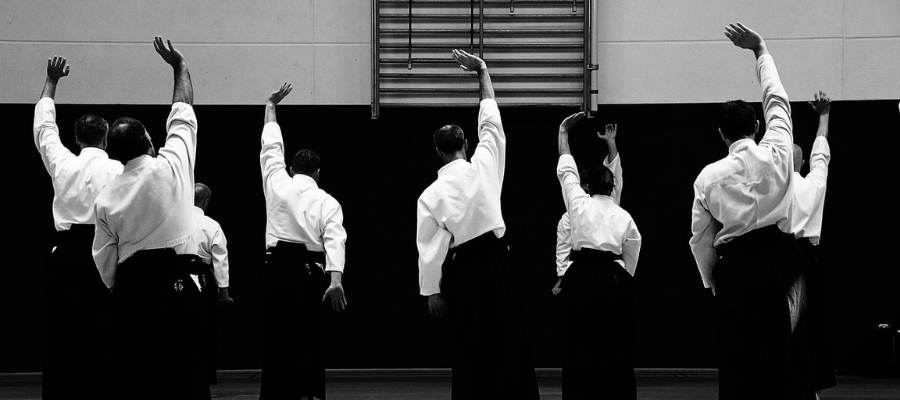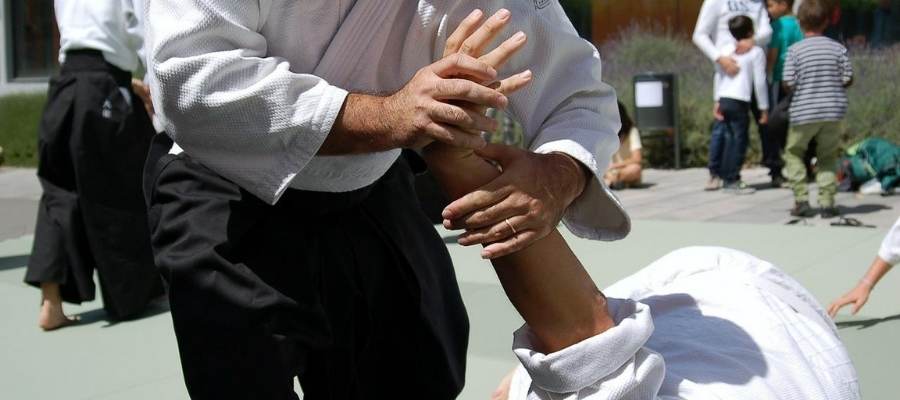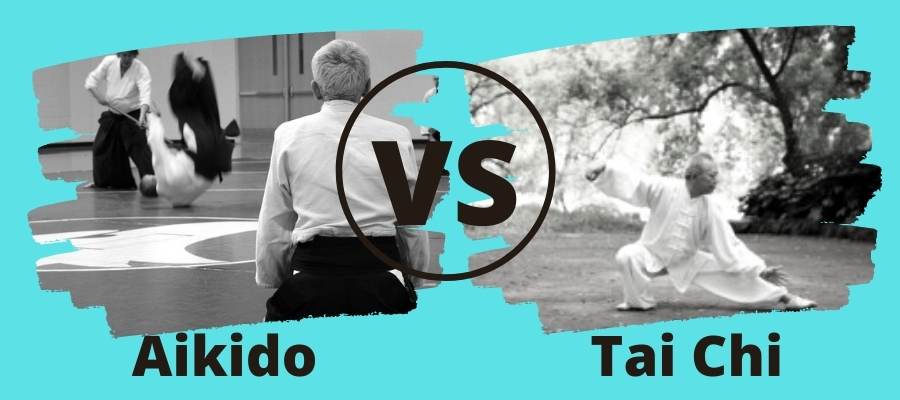Symbiotic is the only way to describe the philosophies, goals, and focuses that aikido and tai chi share. While they are completely different martial arts born out of different cultures and countries, they attract similar practitioners who want to develop internally as well as martial skills. This is also often why people trying to choose between tai chi vs aikido end up trying out both.
Aikido and tai chi are “soft” martial arts that use principles from physics such as momentum and weight to counter the intentions of potential aggressors. They are considered peaceful arts because training includes becoming acutely attuned to the surroundings and acting in response to any changes. The response, even to an aggressor, aims to neutralize and bring harmony back to the situation.
The differences between aikido and tai chi are also great. Whereas tai chi primarily focuses on standing forms and independent work, Aikido focuses on partner work through grappling, rolling on the floor, and throws.
Whether you are a practitioner of tai chi or aikido, there is a lot to be learned from looking at another soft martial art and noting why the masters of both arts put so much emphasis on the shared commonalities. If you are trying to choose between aikido vs tai chi there are some big considerations to make based on your primary interests, level of fitness, and access to a school or training partners.
Let’s compare aikido and tai chi and then at the end see how they stack up against all of the most popular martial arts.

Tai Chi vs Aikido – Origin and Key Differences
With Aikido’s beautiful flowing moves, beautiful uniforms (I think the best in martial arts!), and adherence to tradition, most people are surprised to learn that it is little over a hundred years old. This is a stark contrast to the hundreds of years of tai chi tradition. Secondly, while tai chi began with specific families of practitioners, Aikido traces its lineage back to a single man, Morihei Ueshiba who lives from 1883-1969.
This newness in relative terms is a real bonus because it means we have exact writings and actual video footage of the founder and principle students that carried the art forward.
To understand how aikido and tai chi both share a peaceful and martial focus, we only need to look back at the influences and experiences from Ueshiba’s life. At age 21, Ueshiba entered the military and served in the Russo-Japanese war as the two countries fought for control over portions of Manchuria. After leaving the military he became the head of a pioneer settlement on a large island north of Japan-proper which was seen as an important outpost for stopping the Russian expansion east. So just like the founders of tai chi, Ueshiba’s fighting skills were honed in the military at a time of great need, in a place where fighting and attacks were ever present.
Being stationed on the island of Hokkaido was also important to the development of aikido because it was here that he met and trained with Takeda Sokaku, the founder of Daito-ryu Jujitsu. It’s apparent that Sokaku had a huge influence because of how Ueshiba incorporated the grappling and floor work into aikido.
Fast forward to 1919 and the second half of the relationship between aikido and tai chi can be understood. Ueshiba moved back to the mainland near Kyoto and became heavily involved with a new religious group based on Shintoism. The Oomoto Religion made world harmony and peace a central focus of their new doctrine. They believe that achieving universal harmony would be achieved by each individual focusing on their own personal virtue.
The similarities between aikido and tai chi can be traced back to the shared experiences of the founders of both arts. They were all military men who had their ideas and martial abilities tested in battle. They were also witnesses to the atrocities of war and fighting. They saw that force should be applied with the minimal necessary amount with the goal of self-preservation and neutralizing the situation. They also saw how martial skill and internal harmony could be developed simultaneously.
The Differences Between Aikido and Tai Chi
At this point you would think I was talking about sister-arts but tactically there isn’t anything further from the truth. In the dojo or school, tai chi and aikido are dramatically different. Let’s start with the chief stylistic differences and then compare the arts in seven ways to help you decide between tai chi vs aikido and which one you might want to learn.
Tai chi forms are a series of movements that a person learns incrementally and performs solo. If they practice in a group, there is not usually contact outside of push hands. Aikido is practiced with a partner in stances but most often from the floor. Contact is made continually through joint locks, throws, and pins.
Aikido has a promotional system where as one learns the different techniques and progresses, they are promoted and given a new rank. Tai chi practitioners learn more forms and transition on to higher skillsets and even weapons but there are no belts. Your level of tai chi is based on what you can demonstrate.
Aikido schools will often employ swords or knives as a way of practicing their defensive techniques but do not teach weapons forms. Depending on the style, tai chi can have as many as eight weapons forms with specific training on each weapon.
Hopefully you can see that if you were walking past either of these two classes they would look dramatically different. If you are wanting to choose a martial art that has a balance of internal development and fighting, both are good choices but you will need to weigh a few pros and cons to find the art that is right for you.

Tai Chi Chuan vs Aikido – Fighting and Self Defense
While both martial arts have their histories in armed conflict, aikido is a better choice if you are interested in fighting and self-defense. It is not that aikido is better than tai chi, it’s just that aikido classes spend the bulk of their time working on the fighting applications with partners. Tai chi fighting applications are typically taught (if at all depending on style) after someone has learned the form where aikido practitioners are talking about fighting right from the get-go.
Aikido has standing work and floor work which is really practical in fighting situations. Tai chi’s fighting drills and even push hand competitions are all done standing.
Where they overlap considerably is in fighting strategy. Both aikido and tai chi use the actions of an opponent to dictate how the practitioner is going to respond. Secondly, they teach softness so that this response can be fluid and fast. Thirdly, they both focus on physics principles like balance, angles, and momentum to take full advantage of the opponent. While aikido is primarily defensive and employs blocks, pulling techniques, and joint locks, tai chi additionally has offensive strikes and kicks.
Limited or No Sparring in Aikido and Tai Chi
One of the greatest criticisms of both tai chi and aikido is the fact that they are considered martial arts but have little or no sparring. Tai chi has push hands competitions which is sparring to a degree but there are regimented rules barring open strikes and kicks. So for the most part, sparring has been removed from tai chi. Aikido has never had a tradition of sparring going as far back as Ueshiba. On the other hand, they have continual partner practice and some schools use drills with a number of people attacking one person.
Neither of these arts are great choices if fighting is of great importance to you. You can find some tai chi schools that focus on fighting but most do not. Aikido practitioners also do not have a great record of going up against other fighters. On the other hand, if you have a tremendous interest in the martial aspects but no desire to duke it out anymore, both arts are a safe place to play around a bit.
Physical Fitness
Trying to decide which is better for fitness, aikido or tai chi, is kind of hard to explain. Aikido is a a better physical workout that will get you huffing and puffing if you are in a hard training session. However, the art requires a lot of joint locks, kneeling, and being on the floor which can lead to sustained joint injuries. So if we are talking about physical health, it’s not really a great art to start for an older crowd.
I don’t want you to mistake this critique and think that aikido is dangerous. There is a huge philosophical focus in aikido on saving the body, rolling safely when you are thrown, and minimizing your exposure to injury. But injuries are also in the nature of the kneeling and movements.
Tai chi will not get your heart rate up unless you are doing push hands, weapons, or standing meditation. That is purposeful by design and that is why it is great for all ages. In direct contrast to aikido, tai chi’s circular motions are designed to exercise, strengthen, and repair the joints.
But while Tai Chi helps you grow as a person and improves your health with time, it isn’t as practical for self-defense as Aikido.
Popularity / Availability of Both Arts
Both aikido and tai chi win in terms of being able to find a school and resources online. They are both extremely popular arts that exist in most cities or are a commute away.
Ability to Practice
Tai Chi wins here because it can be done alone and anywhere. It also has the major advantage of being practiced by all age groups. Aikido has to be trained with a partner and in the best of circumstances, the school is large enough so that you can pair up with someone that is your same size, gender, and at the same level of ability as you. I know that aikido is considered a lifelong art but nearly everyone in an aikido school will be young to moderately aged and male. Females do practice aikido but not in any great number.
Community / Socialization
Both aikido and tai chi win in terms of community and socialization. They tend to have close-knit friendly schools. This makes sense considering that most practitioners of both arts are interested in developing themselves as a person as well as physically. In aikido schools the community is hugely important because a lot of trust has to go into someone that is locking and manipulating your joints.
Expense
Tai chi tends to be less expensive than aikido and free classes can be found, but aikido is not prohibitively expensive. All of the money spent goes to class dues and your initial uniform. There are not expenses related to traveling to and being in competitions. Expenses are something you need to ask about though if you are looking into aikido. Two schools in my city are pretty similar size but one charges monthly dues plus belt fees, private lesson fees, testing fees, and students are expected to teach for free once they reach a certain level.

Need for Gear / Location
Tai chi literally requires nothing. Some schools have uniforms or just t-shirts but the goal is just to be comfortable. Shoes for tai chi are important but again, are not expensive. Aikido practitioners on the other hand need an indoor place to train with tatami mats to break your fall and roll around on. Their uniforms, which I think are beautiful are not cheap.
Combining Aikido and Tai Chi
At the highest levels, aikido and tai chi practitioners are after the same thing. They have a martial arts interest, love the history, community, and are interested in pursuing internal and physical development. It makes sense that so many aikido practitioners have tried tai chi or do both. I think they also compliment the shortcomings of each art. An aikido practitioner learns strikes and stance work while a tai chi practitioner improvers this joint locks and ground game.
Here is an summary of a comparison of the two:
A Comparison Chart of Tai Chi vs Aikido
| Consideration | Tai Chi | Aikido |
|---|---|---|
| Self Defense / Fighting | 3 | 3 |
| Physical Fitness | 5 | 4 |
| Popularity / Availability | 10 | 10 |
| Ability to Practice | 10 | 8 |
| Community / Socialization | 7 | 7 |
| Expense | 10 | 8 |
| Need for Gear / Location | 10 | 4 |
| Average | 6.8 | 6 |
Choosing Between Tai Chi and Other Martial Arts
This is one of a series of articles covering the similarities and difference between tai chi and other martial arts. We all have very different personalities and luckily there is a martial art for everyone. What is important is that more people on the planet are pursuing fitness that is functional and addressing their external and internal development. Whatever you choice and where ever you are in life, we all benefit by having more people improve themselves and interact with a like-minded community. Check out how all the major martial arts compare to tai chi be clicking on the headings.
| Consideration | Tai Chi | Kung Fu | Wing Chun | Krav Maga | Muay Thai | MMA | Aikido | BJJ | Karate | Taekwondo |
|---|---|---|---|---|---|---|---|---|---|---|
| Self Defense / Fighting | 3 | 5 | 7 | 10 | 10 | 10 | 3 | 10 | 7 | 5 |
| Physical Fitness | 5 | 8 | 7 | 8 | 10 | 10 | 4 | 9 | 7 | 8 |
| Popularity / Availability | 10 | 8 | 8 | 3 | 5 | 9 | 10 | 10 | 8 | 8 |
| Ability to Practice | 10 | 10 | 4 | 3 | 3 | 4 | 6 | 7 | 6 | 10 |
| Community / Socialization | 7 | 7 | 7 | 5 | 4 | 6 | 7 | 8 | 7 | 7 |
| Expense | 10 | 6 | 8 | 8 | 4 | 4 | 8 | 6 | 8 | 6 |
| Need for Gear / Location | 10 | 7 | 8 | 6 | 4 | 4 | 4 | 4 | 8 | 7 |
| Total | 6.8 | 7.2 | 7 | 6.2 | 5.7 | 6.7 | 6 | 7.7 | 7.2 | 7.2 |


